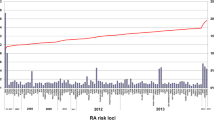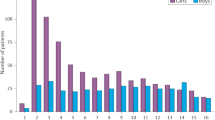Abstract
Epidemiologic studies of pediatric rheumatologic disease are becoming increasingly focused on subfields of epidemiology. Genetic epidemiology is assuming an ever-greater role in the understanding of disease risks and pathogenesis. Such studies involve major histocompatibility complex, cytokine gene polymorphisms, T cell studies, and microarray-based expression technology. Clinical epidemiology, the study of occurrence and outcomes, increasingly relies on multicenter studies with data improving as study parameters become more standardized. With multicenter studies, there is an increasing trend to study ethnic differences in rheumatologic diseases of children.
Similar content being viewed by others
References and Recommended Reading
Thomson W, Donn RP: Juvenile idiopathic arthritis genetics: what’s new, what’s next? Arthritis Res 2002, 4:302–306. This provides an excellent overview of genetic epidemiology, providing perspective on a difficult subject appropriate to clinicians, and highlighting an area of increasing importance in the future study of JIA.
Thomson W, Barrett JH, Donn RP, et al.: Juvenile idiopathic arthritis classified by the ILAR criteria: HLA associations in UK patients. Rheumatology (Oxford) 2002, 41:1183–1189. This study is one of the first to provide substantial evidence that the International League of Associations for Rheumatology subgroups of JIA have some genetic basis for their differences, though the evidence is not uniformly strong throughout the subgroups. Risk factors for disease can be better defined if the genetic component of JIA can be identified as an essential part of the epidemiology of disease.
Zeggini E, Thomson W, Alansari A, et al.: Development of tumor necrosis factor (TNF) polymorphism genotyping and association study with juvenile idiopathic arthritis (JIA) [abstract]. Rheumatology (Oxford) 2002, 41:1–3. This article deals with a large patient cohort. There will be many such studies reported and many such studies are needed to obtain a useful picture.
Date Y, Seki N, Kamizono S, et al.: Identification of a genetic risk factor for systemic juvenile rheumatoid arthritis in the 5’-flanking region of the TNF-alpha gene and HLA genes. Arthritis Rheum 1999, 42:2577–2582. Systemic arthritis has been considered to have a different response to anti-TNF-alpha therapy to the other subgroups of JIA, according to several reports. Therefore, it is relevant that this subgroup of JIA receive close attention regarding cytokines and genetic profiles.
Ozen S, Alikasifoglu M, Bakkaloglu A, et al.: Tumor necrosis factor alpha G-A-238 and G-A-308 polymorphisms in juvenile idiopathic arthritis. Rheumatology (Oxford) 2002, 41:223–227.
Fishman D, Faulds G, Jeffery R, et al.: The effect of novel polymorphisms in the interleukin-6 gene on IL-6 transcription and plasma IL-6 levels, and an association with systemic-onset juvenile chronic arthritis. J Clin Invest 1998, 102:1369–1376.
Fife MS: Increased affinity of a transcription factor complex for the -174G allele of the IL-6 gene augments its transcritional activity: rationale for susceptibility to systemic JIA [abstract]. Pediatric Rheumatology Online Journal 2003, 1:7. http://www.pedrheumonlinejournal.org.
Donn RP, Barrett JH, Farhan A, et al.: Cytokine gene polymorphisms and susceptibility to juvenile idiopathic arthritis. Arthritis Rheum 2001, 44:802–810.
De Benedetti F, Meazza C, Vivarelli M, et al.: Functional and prognostic relevance of the -173 polymorphism of the macrophage migration inhibitory factor gene in systemic juvenile idiopathic arthritis. Arthritis Rheum 2002, 48:1398–1407. This study involved 136 children with systemic arthritis and reports significant associations.
Gattorno M: Phenotypic and functional differentiation of synovial memory T cells in JIA [abstract]. Pediatric Rheumatology Online Journal, 2003. 1:9. http://www.pedrheumonlinejournal.org.
Wedderburn LR, Patel A, Varsani H, Woo P: Divergence in the degree of clonal expansions in inflammatory T cell subpopulations mirrors HLA-associated risk alleles in genetically and clinically distinct subtypes of childhood arthritis. Int Immunol 2001, 13:1541–1550. This study is an interesting work that demonstrates, using excellent science, that T cells play a critical role in the pathogenesis of JIA, nicely complementing other aspects of genetic epidemiology and enhancing understanding of disease risks.
Pascual V: Gene expression analysis of systemic onset juvenile arthritis blood [abstract]. Pediatric Rheumatology Online Journal 2003, 1:8. http://www.pedrheumonlinejournal.org.
Thompson SD: Use of microarrays to categorize childhood arthritis [abstract]. Pediatric Rheumatology Online Journal 2003, 1:6. http://www.pedrheumonlinejournal.org. Microarray studies are topical across many areas of disease, and work is beginning to emerge on JIA and other rheumatic diseases of children. Although the study reported in this abstract is in its infancy, this study and similiar studies will bring much information to the field. Too much data and how to interpret them will be the most significant problems.
Prahalad S, Shear ES, Thompson SD, et al.: Increased prevalence of familial autoimmunity in simplex and multiplex families with juvenile rheumatoid arthritis. Arthritis Rheum 2002, 46:1851–1856. This article in reviewing 110 patients with autoimmunity and their 1228 first- and second-degree relatives and provides very useful family history information and a study of significant size cohort.
Saila H, Savolanien A, Kauppi M, et al.: Occurrence of chronic inflammatory rheumatic diseases among parents of multiple offspring affected by juvenile idiopathic arthritis. Clin Exp Rheumatol 2003, 21:263–265. This Finnish study gives a different aspect to multicase families and nature of the disease in the children.
Saila H, Savolanien A, Kotaniemi KM, et al.: Juvenile idiopathic arthritis in multicase families. Clin Exp Rheumatol 2001, 19:218–220.
Prahalad SL: Juvenile idiopathic arthritis is not associated with birth order [abstract]. Pediatric Rheumatology Online Journal 2003, 1:2. http://www.pedrheumonlinejournal.org.
Manners PJ, Bower C: Worldwide prevalence of juvenile arthritis: why does it vary so much? J Rheumatol 2002, 29:1520–1530. This review highlights many of the problems of comparing epidemiologic studies. It aims to sort out some of the confusion arising from the vastly different prevalence and incidence reported for childhood arthroses and to indicate a way forward whereby epidemiologic studies are much more standardized.
Rosenberg AM, Petty RE, Oen K, Schroeder ML: Rheumatic diseases in Western Canadian Indian children. J Rheumatol 1982, 9:589–592.
Hochberg MC, Linet MS, Sills EM: The prevalence and incidence of juvenile rheumatoid arthritis in an urban black population. Am J Public Health 1983, 73:1202–1203.
Boyer GS, Lanier AP, Templin DW, Bulkow L: Spondyloarthopathy and rheumatoid arthritis in Alaskan Yupik Eskimos. J Rheumatol 1990, 17:4789–4796.
Ozen S, Karaaslan Y, Ozedimir O, et al.: Prevalence of juvenile chronic arthritis and familial Mediterranean fever in Turkey: a field study. J Rheumatol 1998, 25:2445–2449.
von Koskull S, Truckenbrodt H, Holle R, Hormann A: Incidence and prevalence of juvenile arthritis in an urban population of southern Germany: a prospective study. Ann Rheum Dis 2001, 60:940–945. This study involves many participating highly trained physicians. Though the data show relatively low prevalence and incidence of JIA, it would be of interest to know if there is a level of undiagnosed arthritis within the community. This is always a difficult and contentious issue. The data on rheumatic fever in German children is important.
Chia A, Lee V, Graham EM, et al.: Factors related to severe uveitis at diagnosis in children with juvenile idiopathic arthritis in a screening program. Am J Ophthalmol 2003, 135:757–762. This article is of interest because the data are different to that researchers have come to expect with uveitis and children with JIA.
Mendez EP, Lipton R, Ramsey-Goldman R, et al.: US Incidence of juvenile dermatomyositis, 1995–1998: results from the National Institute of Arthritis and Musculoskeletal and Skin Diseases Registry. Arthritis Rheum 2003, 49:3000–3005. This article is a comprehensive study of 671 incident cases of dermatomyositis from across the US over 4 years and provides detailed information on ethnicity and race in particular.
Shamim EA, Rider LG, Pandey JP, et al.: Differences in idiopathic inflammatory myopathy phenotypes and genotypes between Mesoamerican Mestizos and North American Caucasians. Arthritis Rheum 2002, 46:1885–1893.
Marzano AV, Menni S, Parodi A, et al.: Localized scleroderma in adults and children: clinical and laboratory investigations on 230 cases. Eur J Dermatol 2003, 13:171–176.
Herrick AL, Worthington J: Genetic epidemiology: systemic sclerosis. Arthritis Res 2002, 4:165–168.
Arnett FC, Cho M, Chatterjee S, et al.: Familial occurrence and relative risks for systemic sclerosis (scleroderma) in three United States cohorts. Arthritis Rheum 2001, 44:1359–1362.
Garabant DH, Dumas C: Epidemiology of organic solvents and connective tissue disease. Arthritis Res 2000, 2:5–15. This study is of particular interest because organic solvents and their place in association with onset of disease remains of interest to all.
Quartier P, Bonnet D, Fournet JC, et al.: Severe cardiac involvement in children with systemic sclerosis and myositis. J Rheumatol 2002, 29:1767–1773.
Cimaz R, Spence DL, Hornberger L, Silverman ED: Incidence and spectrum of neonatal lupus erythematosus: a prospective study of infants born to mother with anti-Ro autoantibodies. J Pediatr 2003, 142:678–683. Useful and clinically relevant data.
Alamanos Y, Voulgari PV, Siozos C, et al.: Epidemiology of systemic lupus erythematosus in northwest Greece 1982–2001. J Rheumatol 2003, 30:731–735.
Hagelberg S, Lee Y, Bargman J, et al.: Long-term follow-up of childhood lupus nephritis. J Rheumatol 2002, 29:2635–2642.
Sibbitt WL, Jr., Brandt RJ, Johnson CR, et al.: The incidence and prevalence of neuropsychiatric syndromes in pediatric onset systemic lupus erythematosus. J Rheumatol 2002, 29:1536–1542.
Gardner-Medwin JM, Dolezalova P, Cummins C, Southwood TR: Incidence of Henoch-Schonlein purpura, Kawasaki disease and rare vasculitides in children of different ethnic origins. Lancet 2002, 360:1197–1202. This study gives good incident data on two relatively rare diseases.
Author information
Authors and Affiliations
Rights and permissions
About this article
Cite this article
Manners, P.J. Epidemiology of the rheumatic diseases of childhood. Curr Rheumatol Rep 5, 453–457 (2003). https://doi.org/10.1007/s11926-003-0056-y
Issue Date:
DOI: https://doi.org/10.1007/s11926-003-0056-y




